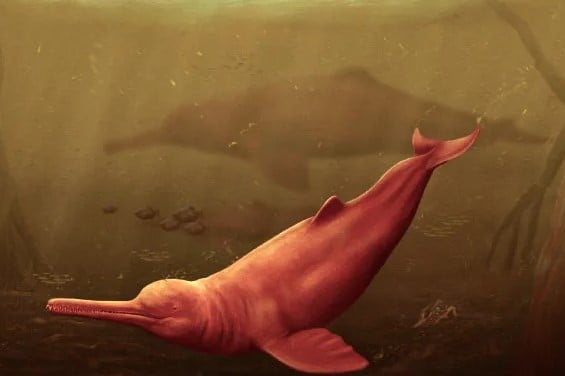The Guardian reported on March 21 that scientists have just discovered the fossilized skull of a giant dolphin that lived in the Amazon River 16 million years ago, believed to have left the ocean to live in rivers in Peru.

The newly discovered dolphin species, scientifically named Pebanista yacuruna, can grow up to 3.5 m long and is the largest freshwater dolphin ever known.
Superhuman size is also noted in contemporary creatures from this region, including fish and crocodiles.
Pebanista yacuruna belongs to the family Platanistoidea, an ancient group of dolphins that lived between 24 and 16 million years ago.
Scientists initially thought they had found the ancestor of the ancient Amazon river dolphin, but were shocked when analysis showed that the South Asian river dolphin was its closest relative.

Fossils of the Pebanista yacuruna species are currently on display at the National Museum of Natural History of Peru. Photo: AFP
The sea monster has all the typical features of Platanistoidea, including a face and specialized bone structures involved in echolocation. Meanwhile, its elongated snout suggests it was a fish-eater.
Its fossils have contributed to the history of the ancient Amazon region.
"Sixteen million years ago, the Peruvian Amazon was very different from today, with much of the current plain covered by a vast system of lakes and lagoons called the Pebas," said Dr Aldo Benites-Palomino, a paleontologist from the University of Zurich (Switzerland).
This ancient landscape included aquatic, semi-aquatic, and terrestrial ecosystems, spanning across present-day Colombia, Ecuador, Bolivia, Peru, and Brazil.
However, about 10 million years ago, the environment changed, the Pebas system gave way to the modern Amazon region, where the prey of these giant creatures no longer existed, so they also became extinct.
The new discovery reflects the threat to existing freshwater dolphin species, all of which face extinction in the next 20 to 40 years, according to lead researcher Aldo Benites-Palomino in a paper published in the journal Science Advances .
A common problem facing river dolphins, including their closest fossil relatives, the Ganges and Indus river dolphins, is the threat of imminent extinction, said Marcelo R Sánchez-Villagra, director of the Department of Paleontology at the University of Zurich. Urban development, pollution and mining are the main causes and are also the causes that are pushing the Yangtze river dolphin to the brink of extinction, according to Sánchez-Villagra.
Minh Hoa (reported by Nguoi Lao Dong, Thanh Nien)
Source


![[Photo] General Secretary To Lam attends the conference to review 10 years of implementing Directive No. 05 of the Politburo and evaluate the results of implementing Regulation No. 09 of the Central Public Security Party Committee.](https://vphoto.vietnam.vn/thumb/1200x675/vietnam/resource/IMAGE/2025/5/19/2f44458c655a4403acd7929dbbfa5039)
![[Photo] President Luong Cuong presents the 40-year Party membership badge to Chief of the Office of the President Le Khanh Hai](https://vphoto.vietnam.vn/thumb/1200x675/vietnam/resource/IMAGE/2025/5/19/a22bc55dd7bf4a2ab7e3958d32282c15)


![[Photo] Close-up of Tang Long Bridge, Thu Duc City after repairing rutting](https://vphoto.vietnam.vn/thumb/1200x675/vietnam/resource/IMAGE/2025/5/19/086736d9d11f43198f5bd8d78df9bd41)
![[Photo] Panorama of the Opening Ceremony of the 43rd Nhan Dan Newspaper National Table Tennis Championship](https://vphoto.vietnam.vn/thumb/1200x675/vietnam/resource/IMAGE/2025/5/19/5e22950340b941309280448198bcf1d9)





























![[Photo] Prime Minister Pham Minh Chinh inspects the progress of the National Exhibition and Fair Center project](https://vphoto.vietnam.vn/thumb/1200x675/vietnam/resource/IMAGE/2025/5/19/35189ac8807140d897ad2b7d2583fbae)





























































![[VIDEO] - Enhancing the value of Quang Nam OCOP products through trade connections](https://vphoto.vietnam.vn/thumb/402x226/vietnam/resource/IMAGE/2025/5/17/5be5b5fff1f14914986fad159097a677)





Comment (0)